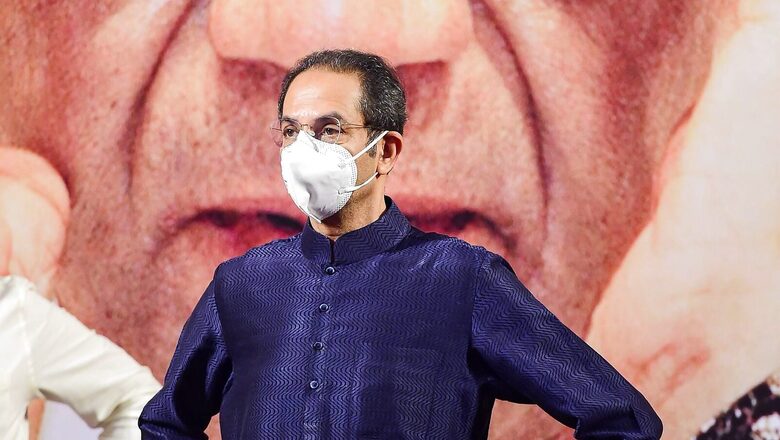
views
It’s not every day that you see a tiger lose grip on his marked territory! It is extremely rare — and when it happens, almost always the tiger falls prey. The Shiv Sena today seems to have not only lost over two-thirds of its elected legislators, but also seems incapable of having enough influence to get its people elected in numbers required to retain or form government. The roaring tiger which used to be synonymous with the formidable Balasaheb Thackeray no longer seems to be an accurate representation of its inheritors: Uddhav and Aaditya.
The journey of the Sena from being an indispensable power centre dictating its terms to now having to stoop to the whims of Balasaheb’s arch political enemies just to stay relevant is a telling lesson in contemporary Maharashtra politics. This is not an overnight event: Sena’s downfall was truly scripted when Uddhav Thackeray began to take control over the party affairs pushing aside mass leaders like Raj Thackeray and Narayan Rane in the years running up to 2003. The warning signs were all there.
In his autobiography, Narayan Rane has written how in the 1999 Maharashtra Assembly elections, Uddhav arbitrarily replaced 15 candidates after the entire list had been signed off by Balasaheb, on the advice of his yes-men. The 15 strongmen who were kicked out contested as independents out of which 11 won — the number which would have helped SS+BJP retain government in Maharashtra. Thus, the 1999 defeat of the SS+BJP’s loss can be directly attributed to Uddhav’s decision making.
In 2004 too, the tickets were sold-off like hot cakes to anyone willing to pay the price quoted by the close coterie, leading to an extremely embarrassing defeat of the party where it lost deposits even in Sena strongholds. Episodes of his erratic behaviour towards party workers have been in conversation within Maharashtra’s power corridors for a long time — for instance (as also written in Rane’s autobiography), he refused to honour his commitment to meet party workers who had come to Mumbai from rural parts of the state, keeping them waiting for days, because he was ‘mourning’ the death of an expensive fish he had bought in Singapore.
Anti-incumbency towards the INC+NCP government combined with the 2014 Narendra Modi wave revived the Sena’s fortunes, bringing them back in power under Devendra Fadnavis’ chief-ministership. However, Sena under Uddhav remained critical of its own government, widening rifts with its ally. At one point the criticism in their mouthpiece Saamna got so loud and regular that many wondered why they didn’t show the courage to just walk out of the government which they were so unhappy with. Disgruntled with the hypocrisy, the Sena ministers and several elected leaders defied the party’s diktat and continued to work in close cooperation under Fadnavis’ leadership. Here is where Eknath Shinde really experienced power, holding key portfolios working in close alliance with the BJP, maintaining a tight grip on the Sena MLAs and ministers in the Fadnavis cabinet.
Come 2019, considering the camaraderie between the Sena ministers (under Shinde’s leadership) and his own and the pace of developmental initiatives in the state which could be attributed to that team-spirit, Fadnavis tried to accommodate Uddhav’s unreasonable demands during their conversations regarding forming a pre-poll alliance. Fadnavis even offered Uddhav his choice of 124 seats, many of which were BJP strongholds to demonstrate his commitment to the alliance. However, the greed for the Chief Minister’s post dictated many of Uddhav’s following actions, namely the unnatural alliance with his father’s political foes — INC+NCP — abandoning the Hindutva ideology, the very core on which Balasaheb had founded the Shiv Sena (Shiva’s army in literal translation).
What Uddhav seemed to have forgotten is that his lust for power isolated the core Maharashtrian party voter who showered their affection on him only due to their allegiance to his late father. Compounded with this was the dissatisfaction among MLAs due to the stepfatherly treatment meted out to them as compared to INC+NCP legislators for whom doors to Matoshree and Varsha always seemed accessible and funds always seemed to come through.
On the other hand, Sena MLAs found themselves stranded outside the power structures, having to beg for funds for their constituencies and a few minutes of conversational time with their Chief Minister. Many of them had contested against the INC+NCP leaders in the same constituencies; hence, the inter-party resentment kept building and there seemed only one man in the party who emerged as a sounding board for the Sena legislators and truly understood their grievances — Eknath Shinde. He heard their problems, helped arrange funds for development works in their constituencies, enquired about their well-being and problem-solved day-to-day constituency issues for each legislator. With the passage of time, the reality of the Sena leaders became more and more distant from their Chief Minister’s ivory tower positions.
Lately, Uddhav Thackeray has been consistently stating in his emotional virtual speeches that if the party thinks he is not capable of leading, he will be happy to step down. Over two-thirds of his legislators have abandoned him for about a week — how much more proof does he need? They have shown no intent to return to Uddhav’s leadership, his new ideologies and new allies. During Balasaheb’s iron-hand leadership this scale of unapologetic, outright ‘bagaavat’ was unthinkable. Since they are in majority it is only obvious they are the true heirs of Balasaheb’s teachings, ideology and political legacy — long abandoned by the current, next gen Thackerays.
The writer is a policy and communications strategist. ‘A Nation to Protect: Leading India Through the Covid Crisis’ is her third book. The views expressed in this article are those of the author and do not represent the stand of this publication.
Read all the Latest News , Breaking News , watch Top Videos and Live TV here.




















Comments
0 comment